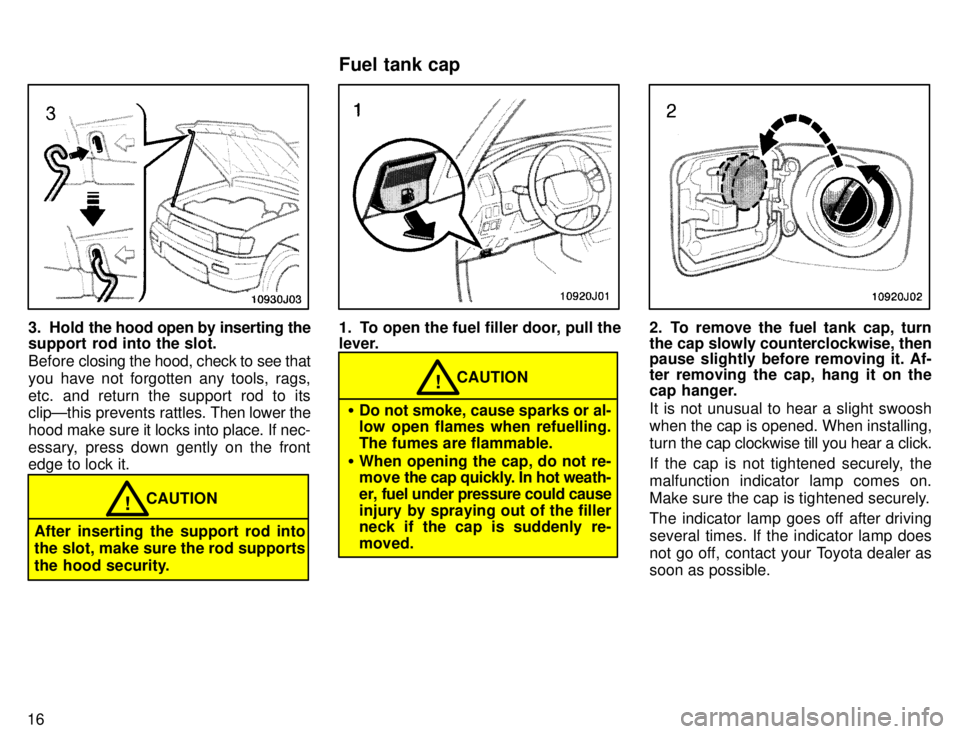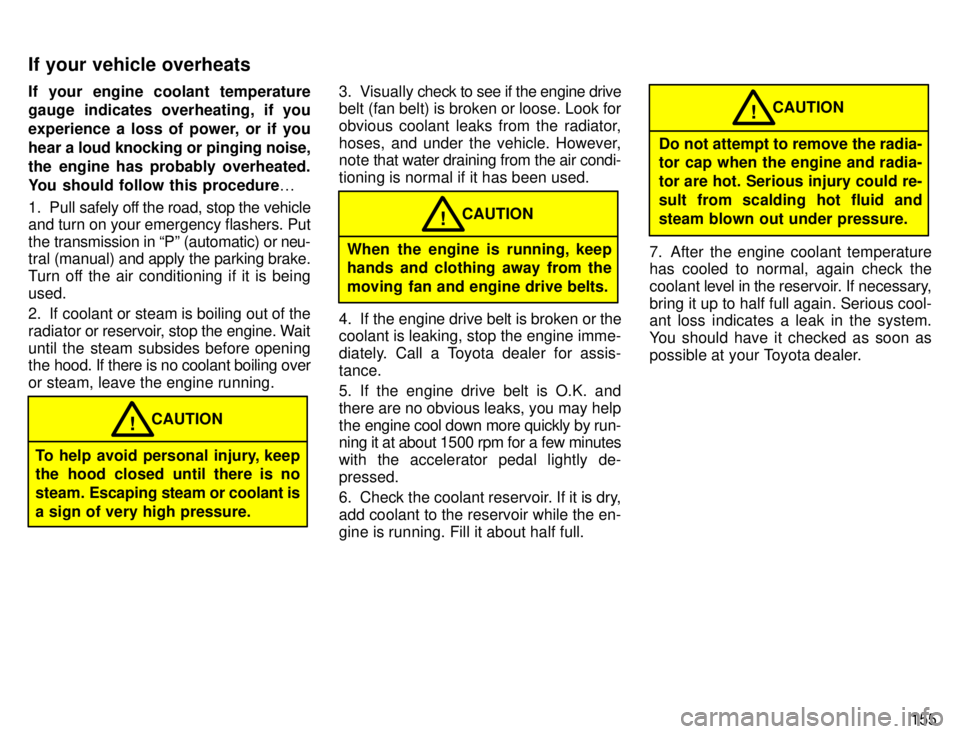1996 TOYOTA 4RUNNER open hood
[x] Cancel search: open hoodPage 3 of 217

21. Side vent
2. Tilt steering lock release lever
3. Instrument cluster
4. Center vents
5. Personal lights
6. Electric moon roof switch
7. Power door lock switch
8. Power window switches
9. Automatic transmission selector lever
or manual transmission gear shift lever
10.Parking brake lever
11. Driving pattern selector button
12. Power back window switch
13. Front drive control lever
14. Lower vent
15. Hood lock release lever
16. Fuel filler door opener
17. Power rear view mirror control switch (with power windows)
Instrument panel overview
Page 16 of 217

15
Type C
LOCKING AND UNLOCKING WITH
POWER BACK DOOR LOCK SWITCH Push the switch.
To lock: Push the switch on the LOCKº side.
To unlock: Push the switch on the UN-
LOCKº side.
Vehicles with a power door lock sys-
temÐOperating the power door lock
switch simultaneously locks or unlocks the back door (see Side doorsº).To open the hood, do the following.
1. Pull the hood lock release lever.
The hood will spring up slightly.2. In front of the vehicle, pull up on the
auxiliary catch lever and lift the hood.
Hood
Page 17 of 217

16
3. Hold the hood open by inserting the
support rod into the slot.
Before closing the hood, check to see that
you have not forgotten any tools, rags,
etc. and return the support rod to its clipÐthis prevents rattles. Then lower the
hood make sure it locks into place. If nec-
essary, press down gently on the front
edge to lock it.
CAUTION!
After inserting the support rod into
the slot, make sure the rod supports
the hood security.
1. To open the fuel filler door, pull the
lever.
CAUTION!
� Do not smoke, cause sparks or al-
low open flames when refuelling.
The fumes are flammable.
� When opening the cap, do not re-
move the cap quickly. In hot weath-
er, fuel under pressure could cause
injury by spraying out of the filler
neck if the cap is suddenly re- moved.
2. To remove the fuel tank cap, turn
the cap slowly counterclockwise, then
pause slightly before removing it. Af-
ter removing the cap, hang it on the
cap hanger.
It is not unusual to hear a slight swoosh
when the cap is opened. When installing,
turn the cap clockwise till you hear a click.
If the cap is not tightened securely, themalfunction indicator lamp comes on.
Make sure the cap is tightened securely.
The indicator lamp goes off after driving several times. If the indicator lamp does
not go off, contact your Toyota dealer as soon as possible.
Fuel tank cap
Page 158 of 217

155
If your engine coolant temperature
gauge indicates overheating, if you
experience a loss of power, or if you
hear a
loud knocking or pinging noise,
the engine has probably overheated.
You should follow this procedure 0
1. Pull safely off the road, stop the vehicle
and turn on your emergency flashers. Put
the transmission in Pº (automatic) or neu-
tral ( manual) and apply the parking brake.
Turn off the air conditioning if it is beingused.
2. If coolant or steam is boiling out of the
radiator or reservoir, stop the engine. Wait
until the steam subsides before opening
the hood. If there is no coolant boiling over or steam, leave the engine running.
To help avoid personal injury, keep
the hood closed until there is no steam. Escaping steam or coolant is
a sign of very high pressure. CAUTION
! 3. Visually
check to see if the engine drive
belt (fan belt) is broken or loose. Look for
obvious coolant leaks from the radiator,
hoses, and under the vehicle. However, note that water draining from the air condi-
tioning is normal if it has been used.
When the engine is running, keep
hands and clothing away from the
moving fan and engine drive belts. CAUTION
!
4. If the engine drive belt is broken or the
coolant is leaking, stop the engine imme-
diately. Call a Toyota dealer for assis-tance.
5. If the engine drive belt is O.K. and there are no obvious leaks, you may help
the engine cool down more quickly by run- ning it at about 1500 rpm for a few minutes with the accelerator pedal lightly de-pressed.
6. Check the coolant reservoir. If it is dry,
add coolant to the reservoir while the en-gine is running. Fill it about half full.
Do not attempt to remove the radia-
tor cap when the engine and radia-
tor are hot. Serious injury could re-
sult from scalding hot fluid and
steam blown out under pressure. CAUTION
!
7. After the engine coolant temperature
has cooled to normal, again check the
coolant level in the reservoir. If necessary,
bring it up to half full again. Serious cool- ant loss indicates a leak in the system.
You should have it checked as soon as
possible at your Toyota dealer.
If your vehicle overheats
Page 178 of 217

175
Tire surface and wheel nuts Check the tires carefully
for cuts, damage
or excessive wear. See Chapter 7-2 for
additional information. When checking the tires, make sure no nuts are missing,
and check the nuts for looseness. T ighten
them if necessary.
Tire rotation
Rotate the tires every 12000 km (7500
miles). See Chapter 7-2 for additional in-formation.
Fluid leaks Check underneath for leaking fuel, oil, wa-
ter or other fluid after the vehicle has been
parked for a while. If you smell fuel fumes
or notice any leak, have the cause found
and corrected immediately. Doors and engine hood
Check that all doors including back door
operate smoothly and all latches lock se-
curely. M ake sure the engine hood secon-
dary latch secures the hood from opening
when the primary latch is released. INSIDE THE VEHICLE Items listed below should be checked
regularly, e.g. while performing peri-
odic services, cleaning the vehicle,etc. Lights Make sure the headlights, stop lights, tail lights, turn signal lights, and other lights are all working. Check headlight aim. Service reminder indicators and
warn-
ing buzzers Check that all service reminder indicators
and warning buzzers function properly. Steering wheel
Check that it has the specified freeplay.
Be alert for changes in steering condition,such as hard steering or strange noise. Seats Check that all seat controls such as seat
adjusters, seatback recliner, etc. operate
smoothly and that all latches lock securely
in any position. Check that the head re-
straints move up and down smoothly and
that the locks hold securely in any latched
position. For folding-down rear seat-
backs, swing-up rear seat cushions and
detachable temporary third seat, check
that the latches lock securely. Seat belts
Check that the seat belt system such as
buckles, retractors and anchors operate
properly
and smoothly. Make sure the belt
webbing is not cut, frayed, worn or dam-aged. Accelerator pedal Check the pedal for smooth operation and
uneven pedal effort or catching. Clutch pedal Check the pedal for smooth operation. Brake pedal Check the pedal for smooth operation and
that the pedal has the proper clearance. Check the brake booster function. Brakes
At a safe place, check that the brakes do not pull to one side when applied. Parking brake Check that the lever has the proper travel and that, on a safe incline, your vehicle is
held securely with only the parking brake applied.
Page 204 of 217

201
Light bulbs
Bulb
No.WType
HeadlightÐ60/55A
Parking and front side marker lightsÐ5C
Front turn signal lights115627B
Rear turn signal lightsÐ21C
Stop and tail lightsÐ21/5C
Back-up lightsÐ21C
License plate lightÐ5C
High mounted stop light92118C
Interior lightÐ8D
Personal lightsÐ8D
Glovebox lightÐ1.4C
Luggage compart- ment lightÐ8D
A: HB2 halogen bulbs
B: Single end bulbs
C: Wedge base bulbs
D: Double end bulbs
1. Open the hood. Unplug the connec-
tor. Remove the rubber cover. If the connector is tight, wiggle it.2. Release the bulb retaining spring
and remove the bulb. Install a new
bulb and the bulb retaining spring.
To install a bulb, align the tabs of the bulb with the cutouts of the mounting hole.
ÐHeadlights